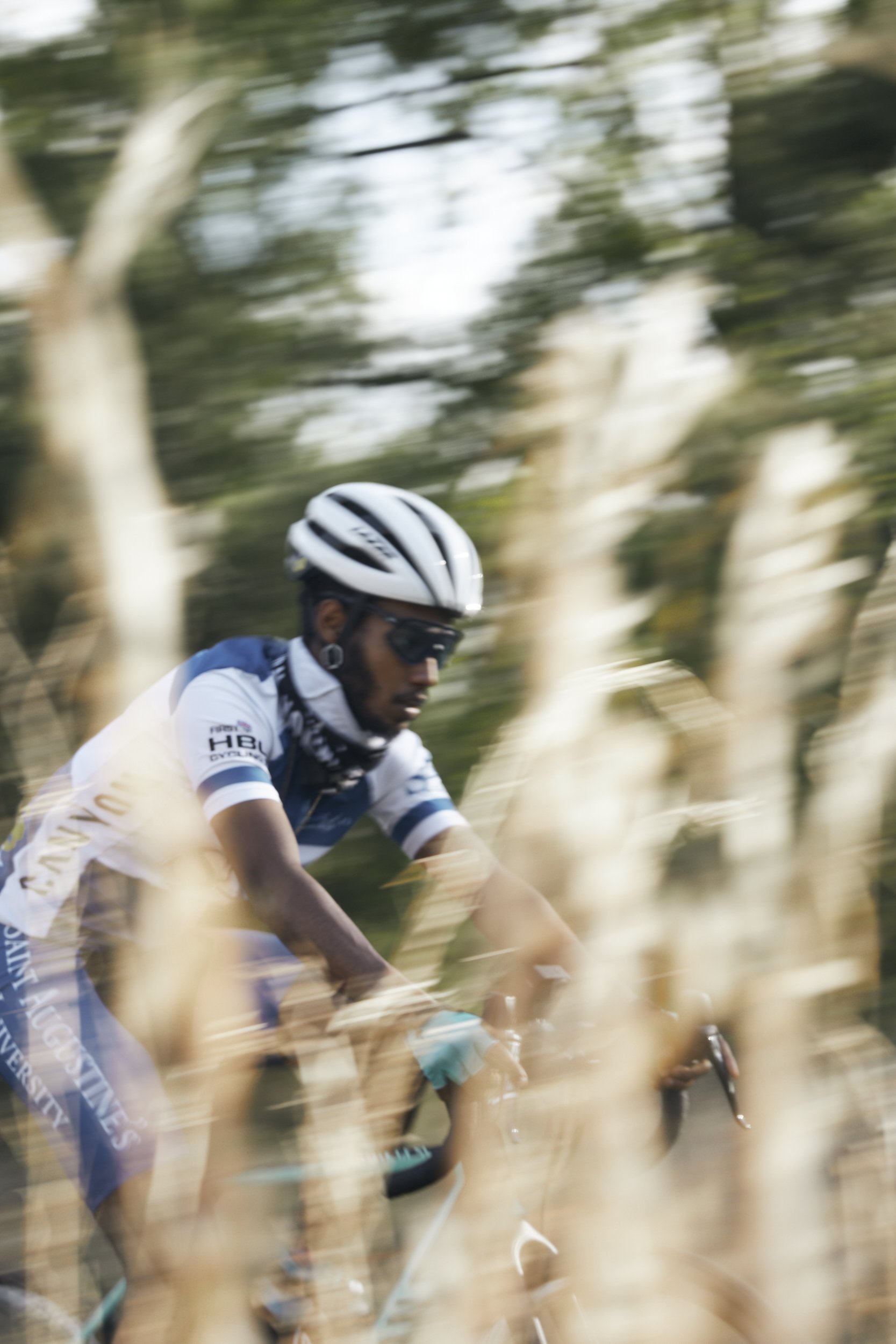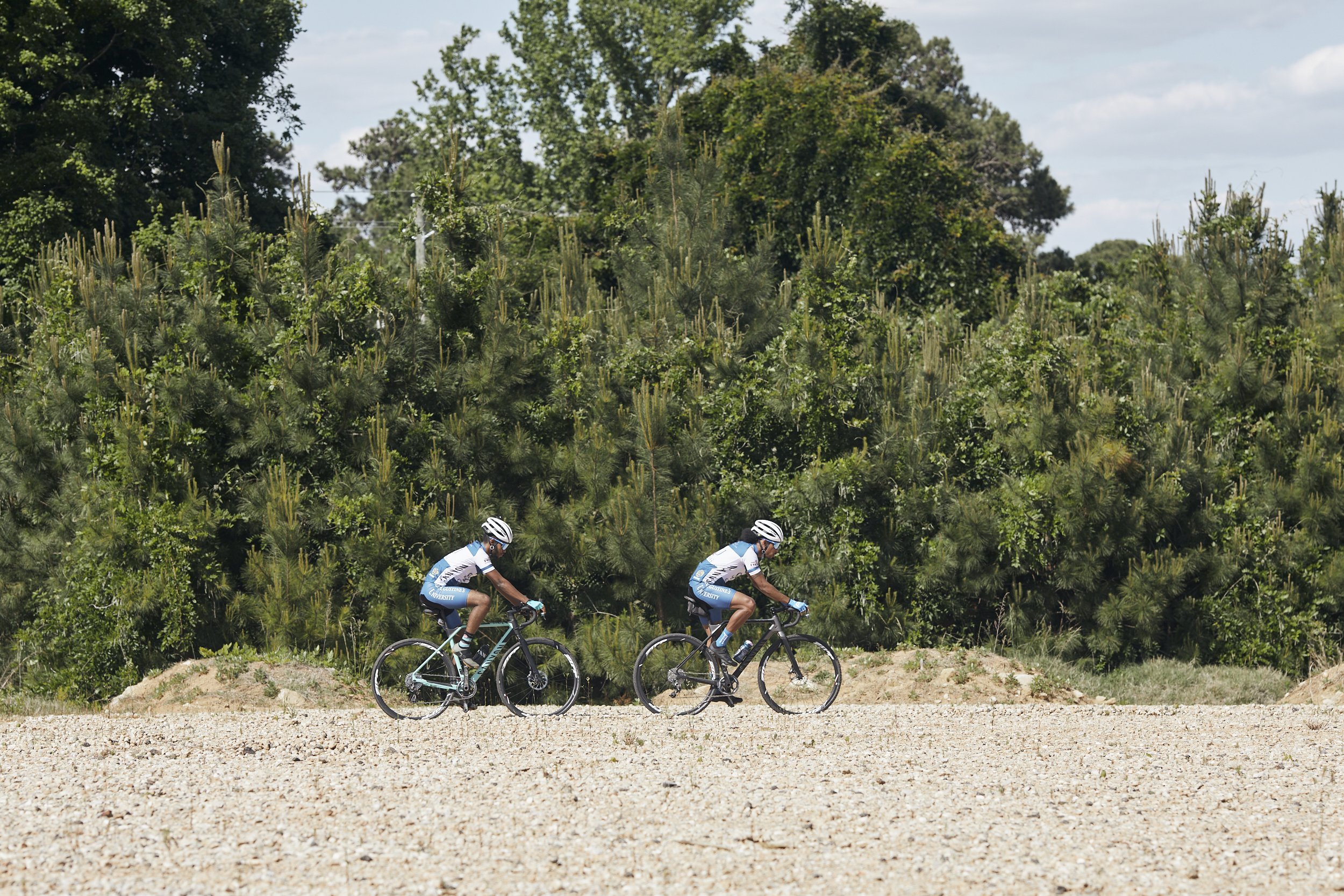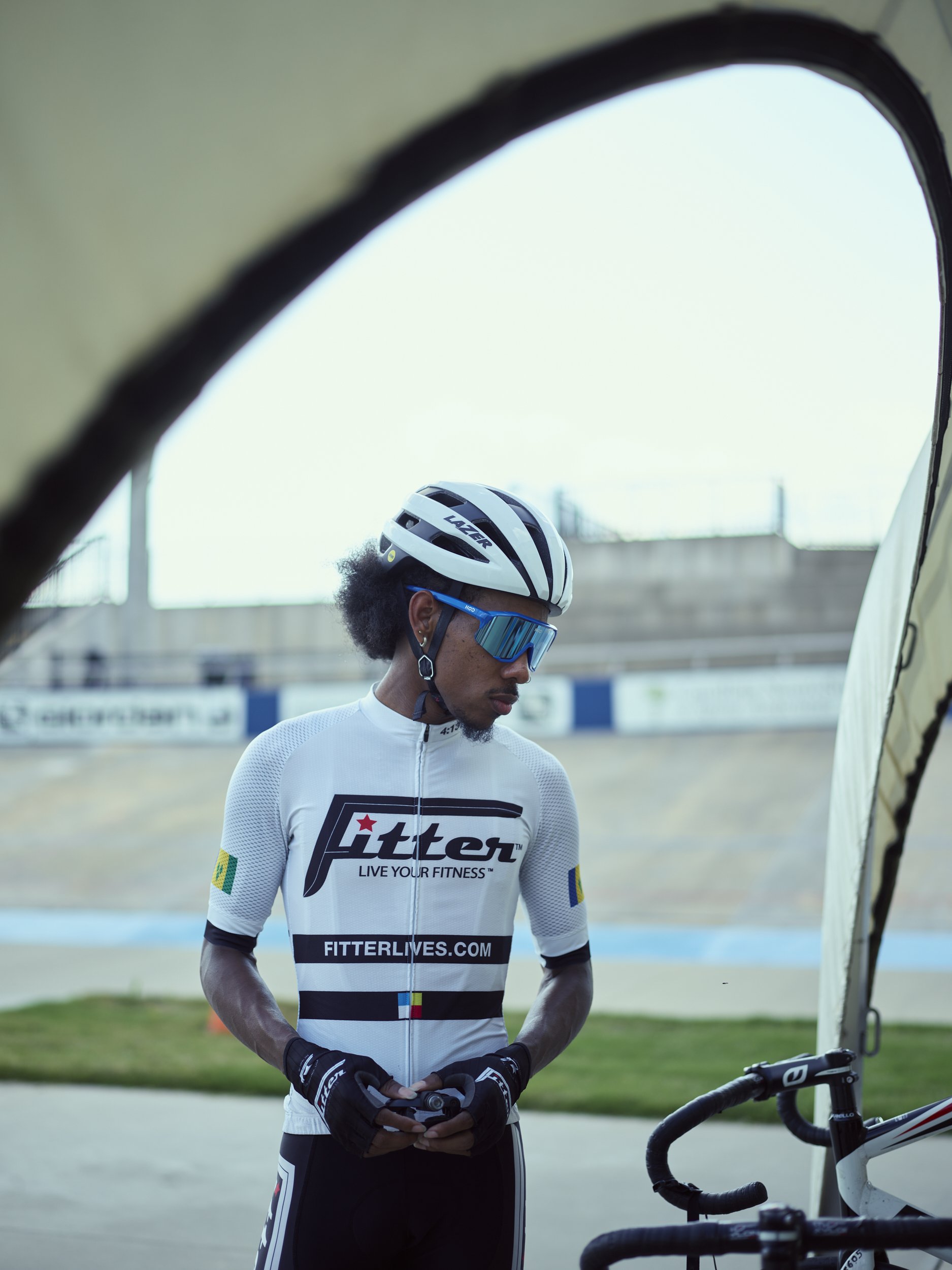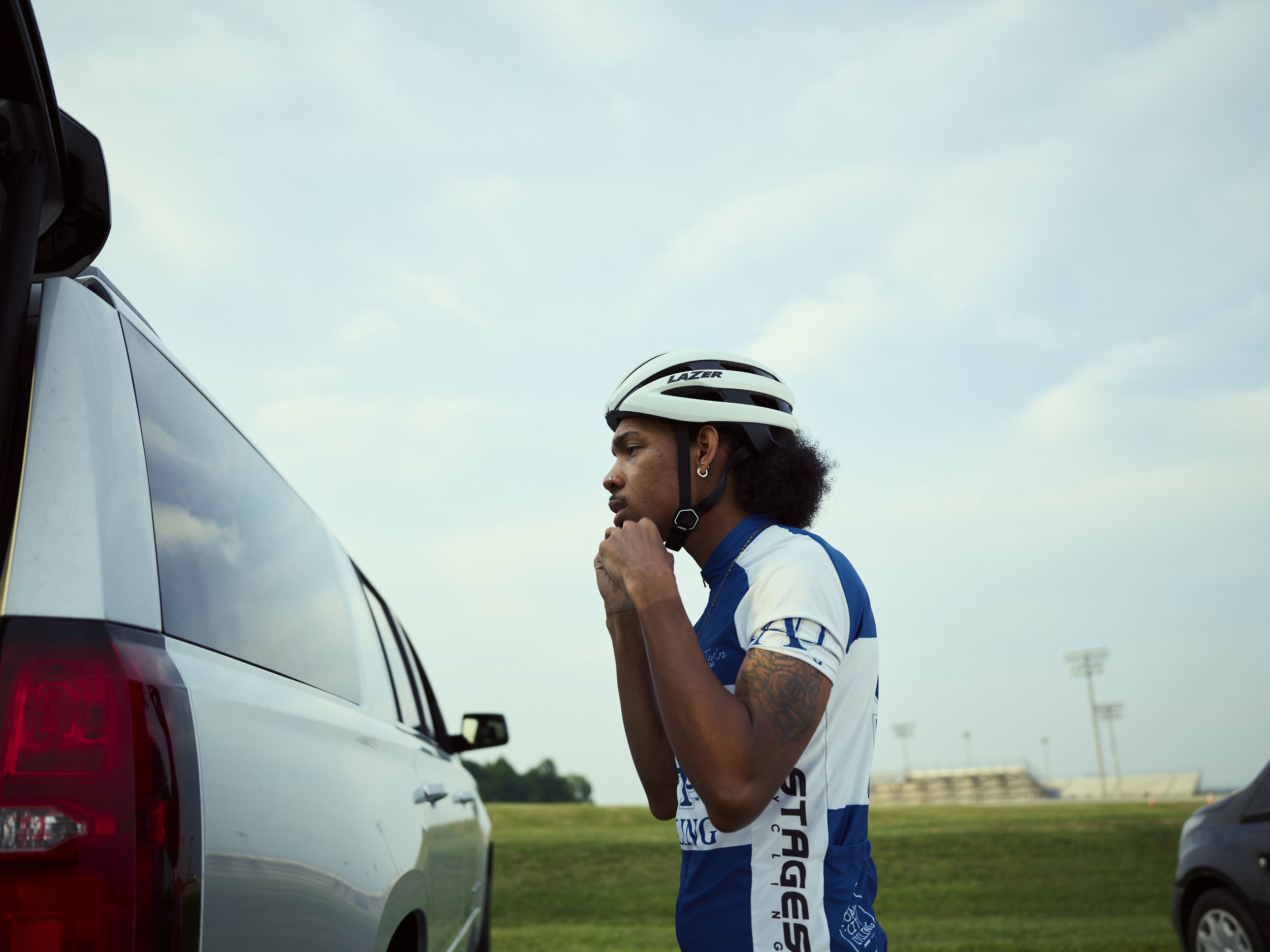A group of students from Saint Augustine’s University — during the pandemic and with very little cycling experience — trained hard and became the first competitive cycling team at a historically Black college or university.
Words & Photos by Joshua Steadman
It was a foggy September morning in 2020 when a documentary crew began filming the St. Augustine’s University (SAU) cycling team’s first season for the Canyon Bicycles-sponsored series “Chasing History.” The haze eventually burned itself out, leaving behind a clear, sunny day, perfect for a training ride for the new cyclists around the school’s roughed-in course tucked behind the George Williams Athletic Complex and marked by orange construction cones. Many of the riders wore bike shorts for the first time, some fumbled with their cleated shoes and pedals, and all of them were completely absorbed with learning the sport.
In its first year, the SAU cycling team was made up of 12 student athletes. These co-ed mixed clubs are the norm at the varsity cycling level. The students were completely new to competitive cycling, with the exception of Ashley Weekes, a freshman from Barbados who has national and international triathlon experience. In 2018, she competed in the qualifier for the Youth Olympic Games. In Barbados, Weekes “always had a bicycle [to] ride around the neighborhood.” When she turned 15, she looked into road cycling, and liked what she saw.
But the rest of the team? As Brandon Valentine-Parris — former Olympic sprinter from St. Vincent and the Grenadines, 2020-21 season captain, and now one of the coaches of the cycling team at SAU — put it in a Zoom call with the North Carolina Bicycle Club (NCBC) in mid-July this year, “We were sponges for information.”
Mark Janas, one of the team’s coaches, is a professor at SAU and teaches a variety of sports communication and business courses. In addition to designing courses in esports management, he’s also an amateur cyclist. “It’s been rewarding to see how excited the students get, and some of them have truly fallen in love with cycling,” Janas said. “It’s something that they’ll be able to continue doing long past their college careers.”
(Left to right) Tom Bell, Jeremiah Bishop, Brandon Valentine-Parris, and Finote Weldemariam at the Giordana Velodrome in Rock Hill, South Carolina. Valentine-Parris’ favorite form of cycling is cyclocross. A former Olympic sprinter from St. Vincent and the Grenadines, Valentine-Parris is currently one of the coaches of the SAU cycling team. “I’m a sprinter, so I love to go really fast for an hour.”
Due to masking and social distancing requirements, the team concentrated primarily on cyclocross, gravel, and virtual racing in its first year.
That’s actually only about half of the categories of competitive racing available. Janas put it this way: “It’s not a single sport, it’s almost more like four or five different sports, all that require their own training, training techniques, technology, and coaching.”
Cyclocross, one of the newest disciplines in cycling, is a mashup of mountain biking, road biking, and steeplechase. Aaron Kellogg, one of the riders for Oak City Cycling (a sponsor of the SAU cycling team) described a local route called Spring Hill that can double as the mold for all cyclocross courses:
“There are some straight, fast sections on the route; there are windy, more technical turns that rely on your bike-handling skills. … It also involves sections where you actually have to get off your bike. There are barrier sections that you go through, [and] there are a set of stairs that are built into this course.”
Yes, in this particular flavor of cycling, riders hop off bikes and carry them over obstacles, hustling up stairs or jumping over boards and rocks.
Weldemariam rides the gravel course at St. Augustine’s University in Raleigh, North Carolina. A member of the inaugural cycling team, he was born and raised in Eritrea and moved to the U.S. in 2012. Weldemariam graduated from St. Augustine’s in 2021 and now works in the school’s Office of Marketing and Communications.
Gravel racing happens on a combination of surfaces, ranging from asphalt to gravel, including dirt, single-track trails, and maintenance roads.
Virtual racing is happening for the team through the Zwift, RGT, & RevoRace platforms, which only need to interface with power meter information from home trainers (in this case, school trainers) to plot the in-app character’s place during races. The availability of this technology dovetails nicely with Janas’ plan to establish St. Augustine’s sports teams in the esports category, a designation currently rippling across campuses around the country.
Through corporate sponsors Saris and Stages Cycling, according to a June 2021 blog post on the university’s website, the team was able to secure smart trainers and bikes that allowed the entire team to train and race indoors.
Valentine-Parris and Weldemariam practice cycling on gravel, one of many categories in competitive racing.
The team, in spite of virtual training and races, hadn’t been able to ride as much as expected during the 2020-2021 season, and it looks like the second season of SAU’s cycling team will be a rebuilding year. 2020’s socially distant year of eight virtual races and participation in the USA Cycling Collegiate Cup was a challenge, but Janas and Umar Muhammad, co-coaches of the team, have kept this first-year squad together and are upbeat and energetic when they speak about the coming year.
“We’re excited. The cycling team is a new part of our program that we wanted to engage our students in,” Muhammad said.
Valentine-Parris changes pedals at the Giordana Velodrome. “Learning what [Marshall Walter “Major” Taylor] did for the sport and who he was in this sport; learning that he can just come from being a regular guy who likes bikes to being a world champion, the first Black world champion ... I mean, come on. If he can do it, why can't I? I think that’s what he wanted to show everybody in his time in the sport,” Valentine-Parris said. “Nelson [Vails] was from Harlem, and he was a track cyclist, and ... in his time as a pro cyclist, he was the best at what he did. And you see a trend. It only takes a few to actually go out there and tell everyone, ‘You can do it, so can I.’ And that’s the message at St. Augustine’s University as well. We wanna show that regardless of who you are, where you’re from, the color of your skin, how tall, small you are, where you’re from, it doesn’t matter ... you can get it done.”
Valentine-Parris before a race in Rock Hill, South Carolina. “I never thought I would love cycling this much.”
Finote Weldemariam is a 2021 graduate of St. Augustine’s and was a member of its fledgling cycling team. In mid-April 2021, he prepared for a training ride on campus and led the way to SAU’s bike shop: a cinder-block room with road bikes hanging on one wall and a large table in the center for working on the team’s bikes. Weldemariam flipped his bike over, checking the tire pressure and brake lines on his Canyon Inflite before the ride. Like most of the cyclists on the team, Weldemariam was new to cycling.
SAU, with current enrollment at around 1,000 students, is nestled in downtown Raleigh, North Carolina. Named after the bold North African leader of Western religious thought, Augustine of Hippo, and established in 1867, the school was among the first HBCUs established in North Carolina during Reconstruction.
Weldemariam wears a lion pendant around his neck. In the Tigrinya language of Eritrea and Ethiopia, the word for lion is anbesa. “That's a word we use often,” he said. “And there's another word that I love, which is negus, king. And those are the two words that I always wanted to connect with myself. Whenever you achieve something or ... do something good, they always say, ‘Anbesan.’ That means ‘Good job; you know what you're doing.’ I used to be scared of lions when I was a kid. Whenever I used to watch movies. ... Now, I can face my fear. Just put them right here next to me [taps chest]. Yeah, you can't be afraid of the lion when you are the lion.”
Weldemariam checks his tire pressure in SAU’s bike shop, a cinder-block room with road bikes hanging on one wall and a large table in the center for working on the team’s bikes.
On June 19 (“Juneteenth”) of this year — a national holiday marking the emancipation of enslaved people in the United States — and with the team fully vaccinated, Valentine-Parris and Weldemariam, two of the top riders on the team, participated in an in-person race. This category 4 & 5 race in the MAC Racing Series took place on the paved criterium (crit) course, a 1.1-mile loop in Rock Hill, South Carolina. Racers start in the novice category (which used to be classified as category 5 in cycling) and work their way down in numbers; category 1 is the top tier. This 50-minute race, filled with tight turns and repeated stretches of climbs and downhill racing, is a quick and fierce battle, with lots of opportunities for contact and crashes. And it’s extremely exciting to watch.
“It's a big deal for the Black community, and having to be the first HBCU cycling team [to] have their first event on that particular date — it was a really big deal for our community,” said Valentine-Parris. “We just wanted to make it the best experience that we can possibly have, and that was all we were celebrating — freedom; and celebrating the team.”
Valentine-Parris and Weldemariam, two of the top riders on the team, participated in an in-person, category 4 & 5 race on June 19, 2020. The 50-minute race, filled with tight turns and repeated stretches of climbs and downhill racing, is a quick and fierce battle, with lots of opportunities for contact and crashes.
In addition to the Juneteenth crit being their first major event, the pair needed racing bikes. The hybrid bikes they had been using for cyclocross events with the team weren’t suitable for the track. So Canyon Bicycles, the sponsor of the ongoing documentary, stepped up and loaned them road bikes from its Endurance series of frames. As a further show of support for both athletes, professional rider, cycling coach, and Canyon ambassador Jeremiah Bishop drove the bikes to the race. During the race, he kept up a near-constant stream of suggestions and tips for the duo, although he pointed out that he wasn’t coaching them so much as guiding them for this particular race.
The experience was an eye-opener for Weldemariam, and having Bishop on their side was a huge advantage. “We had someone that had been in a race, been able to win those races, and become a champion.”
Both racers finished in the bottom half of the pack, a result that was expected, and not disappointing to Bishop. He praised both cyclists’ early positioning in the pack, as well as their huge physical efforts during the race.
“I think with time and with the right work, the guys can continue to climb,” Bishop said. “The trajectory is really steep at this point, and we’ve just got to keep them rolling and keep them having fun.”
“Hang in there, because eventually, you'll get a tailwind.”
Valentine-Parris had a leg cramp about two-thirds of the way through the race, and limped through the final laps. Weldemariam finished with a sore back and a new appreciation for the level of cycling required for crit races: “We had a blast. We probably had some moments [where] we were like, ‘Why am I here?’ But it was the fun that drove us into completing that race, and being able to learn something different we didn't know.”
Weldemariam (left) and Valentine-Parris.“It’s been rewarding to see how excited the students get, and some of them have truly fallen in love with cycling,” said Mark Janas, head coach of the SAU team. “It’s something that they’ll be able to continue doing long past their college careers.”
The experience was positive for Valentine-Parris, in particular.
“Cycling was supposed to be my cross-training for track and field … [but] I fell in love with cycling,” he said at the end of the call with NCBC. “I rode a bike September the 13th [of last year] for the first time, and never looked back.”
In the final few moments of the footage from the documentary, you can hear Weldemariam and Valentine-Parris at the end of the race, over the sound of shoes clipping out and the spin of gears:
Weldemariam: Good race. Good race. We learned a lot today. ... My legs felt like noodles.
Valentine-Parris: Oh, man. Bro — I coulda had it.
Click here to watch the first episode of “Chasing History” and find out more about the documentary.
Joshua Steadman is a lifestyle, portrait, editorial, and commercial director and photographer based in North Carolina. As the son of a newspaperman and a teacher, he inherited a love of learning and telling stories.


















